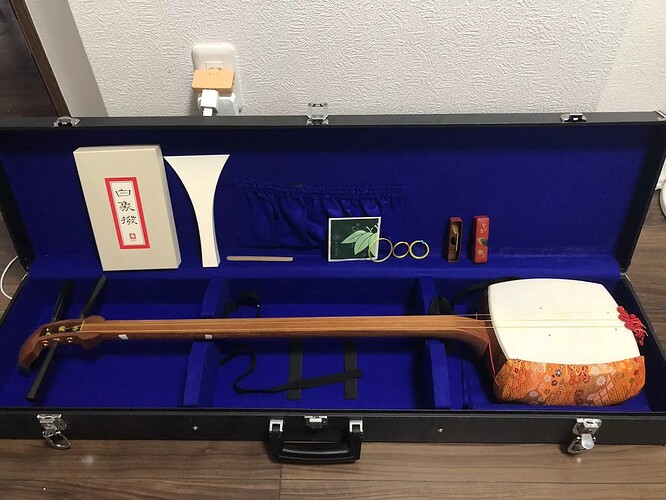Brand new to shamisen, want to buy this used one, but idk what’s good or not. The skin is intact, front and back. In other pics, the neck looks straight and smooth, and the tenjin and itomaki look good as well close up. What else do I need to look for? And, what style is it? It looks like a hosozao to my uninformed eye.
Howdy
If you’re not sure about something it’s better not to pull the trigger when buying used. I will tell you what I see but from this single picture I cannot tell very much.
This instrument is made of karin (padauk, of one sort or another). The itomaki are ebony (of a sort). The front skin looks fine at a glance. I cannot tell if it is natural or synthetic. There are four dots on the skin. These four dots may be pencil marks or they may be holes. If the latter, this is a cat skin. If the former, it is more likely a dog skin or synthetic made to look like a cat skin.
The instrument has a simple yama-sawari. The neck ends in a hatomune. These days, hatomune are most commonly found on hosozao instruments, but are not unique to them by any means.
One of the accessories included is a kouta style koma. Kouta shamisen use hosozao and chuuzao necks. They typically have a body that is slightly larger than a nagauta and equivalent to a min’yo. However a large bachi is also included. Kouta does not use bachi. With these two points at odds it’s difficult to draw any conclusions.
I do not guess at dimensions without data. Likely, your auction (or mercari) listing has that information. If you link me to it, I will take a better look.
In the meantime, you might take a look at Bachido’s store. There are used shamisen available and confirmed to be in good, playable condition.
Thanks for the insight! Is there any reason why you couldn’t play the shamisen with a kouta koma and a bachi? Here’s the link to the listing: Japanese Shamisen Hard Case Set Music Traditional 3String Instrument Orange | eBay
Kouta koma are generally very tall and broad, which can make bachi use tricky if you’re not accustomed to such high action.
But it doesn’t invalidate it out of hand, and I have some suspicions regarding the combination which are yet to be confirmed.
That makes sense. I play a few other stringed instruments, and high action is definitely a killer. What kind of suspicions?
There is no dimensional data. So that’s a dead end.
The position marks are held on with tape. If they have been on for a long time, it has likely damaged the wood underneath. The grain on the dou is very striking. I’m pretty sure the marks are pencil, so it’s more likely dog or synthetic.
It is possible that the shamisen in question was previously used for hauta - if all of the accessories are original to the listing. Hauta and Kouta shamisen share much of the same DNA. The former predates the latter, but the sub-genre of “edo-mae kouta” is fundamentally hauta music played in a kouta way. The instruments therefore share some features, and the exact lines between the two remain fuzzy for me. Further research is necessary.
Fascinating. There’s a lot more to shamisen styles than I thought. Just an idea, is it possible for a person to buy multiple koma of different heights, and put on whichever koma suits the playing style of the moment? Or would that put undue stress on the skin?
It is entirely normal to do so.
Koma come in different heights, weights, shape, and materials. All of these change aspects of the sound.
Certain ranges of these qualities are associated with given genres.
A shamisen of that genre’s default action (the 'ha")is likely set with that range in mind, but there’s little stopping you from playing around.

